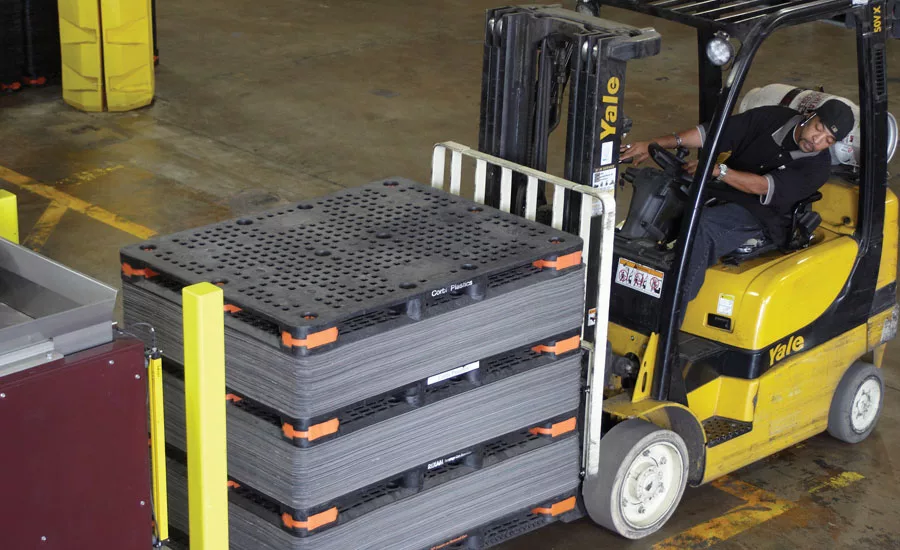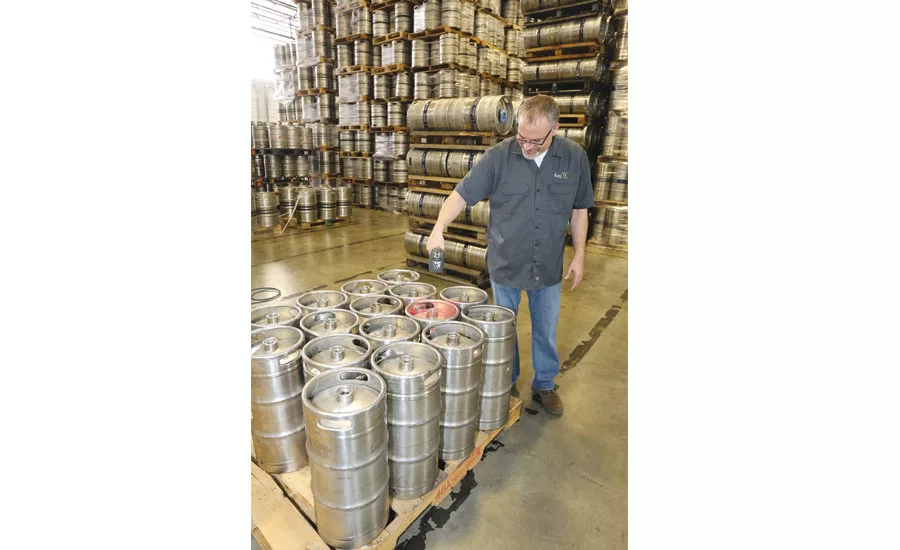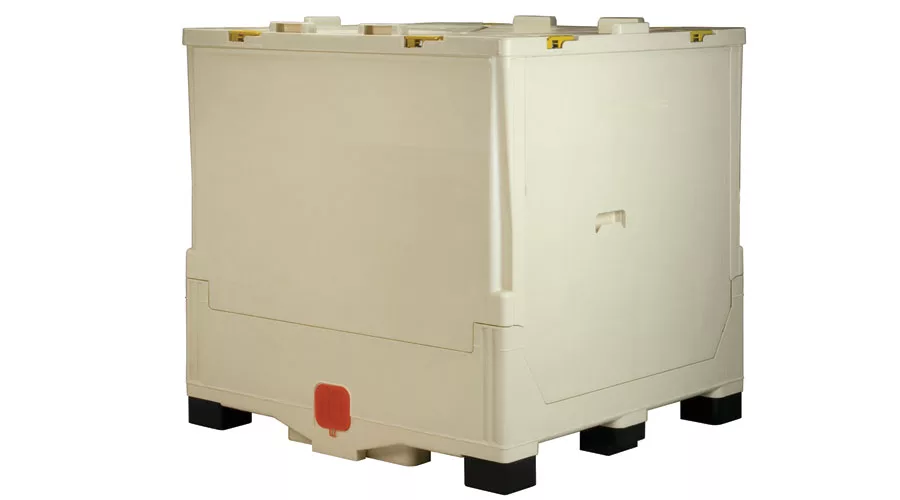Reusable packaging offers economic, social and environmental savings
ROI and environment influence supply chain systems



Buckhorn’s Caliber intermediate bulk container is rail-certified and can be stacked as many as five high with as much as 3,307 pounds. (Image courtesy of Buckhorn Inc.)
With the push to recycle paper, plastic, aluminum cans and more, incorporating reusable packaging into the supply chain never has been more pertinent. It not only minimizes a company’s carbon footprint, but it also reduces overall packaging costs, provides a rapid return on investment (ROI) and improves transportation efficiency through standardized loads, resulting in fewer trips and reduced fuel costs, according to the Linden, Va.-based Reusable Packaging Association (RPA).
Constructed of durable materials such as metal, plastic or wood and designed to withstand the rough handling of a typical warehouse logistics system, reusable packaging includes reusable pallets, racks, bulk containers, handheld containers and dunnage that move products efficiently and safely throughout the supply chain, the RPA notes.
The growth of small-format retailers has driven the need for more efficient distribution and merchandising of goods at smaller stores, according to Orbis Corp.’s Marketing Communications Manager Samantha Goetz. “This has increased the demand for small-format pallets that easily move in smaller doorways, narrow aisles and limited backroom space,” she says.
The Oconomowoc, Wis.-based company also suggests that packaging providers document the impact of reusable versus single-use packaging in terms of greenhouse gas emissions, solid waste and energy usage.
Efficiency, safety, sustainability
One of the broadest issues impacting the returnable container market is food safety, according to Mark Gruber, national intermediate bulk container sales manager for Milford, Ohio-based Buckhorn Inc.
“The Food Safety Modernization Act has driven customers to look more closely at eliminating wood and cardboard from their operations in an effort to prevent contaminates from being introduced into their systems,” he says. “We’ve also seen a trend with customers looking for a collapsible alternative to the drum or bottle-in-cage for a more efficient return and warehouse space savings.
“Finally, with consumers wanting additional choices in beverage flavors, it’s important that supply chains offer packaging that is efficient, flexible and right-sized,” he continues. “Reusable collapsible intermediate bulk containers (IBCs), bulk boxes, pallets and handheld containers give brand owners the right choices to deliver the breadth of choices consumers expect in packaging. This drives work-in-process efficiency, safety and sustainability.”
With the craft beer industry’s continuing growth, brewers that understand and refine their supply chains can gain a competitive edge, says Scott Moorad, vice president of innovation for Houston-based Satellite Logistics Group (SLG).
“Savvy brewers are optimizing their supply chains by leveraging proven keg management practices and asset-tracking technology to get kegs back faster and more cost effectively, so they can serve the marketplace with fewer kegs. This is important because kegs average $130 each — a significant investment for brewers,” he says. “Reusing kegs also helps to minimize brewers’ impact on the environment, keeping kegs out of the landfill and minimizing the energy use associated with recycling.”
Moorad adds that there are significant differences in the environmental footprint of stainless steel kegs versus disposable plastic kegs. “Reusable plastic kegs have a lifecycle of 10 years or less and are intended for one-time use, so more kegs are required to meet brewers’ needs. …Steel kegs, on the other hand, are made to last 30 years or more, so fewer kegs are needed. Effective keg management services like SLG’s Kegspediter ensure that kegs are returned efficiently and cost effectively.”
Returnable stainless steel kegs are a sustainable solution in the craft brewing industry, and an effective keg management system allows a brewery to service its distribution market with fewer kegs, Moorad says. SLG collects unsalable products using its EcoBev service to ensure products are disposed of in an environmentally friendly manner that complies with Environmental Protection Agency (EPA) requirements, he adds.
“To reduce the water-usage footprint, liquid is separated from its glass or aluminum containers, which are also recycled, and is treated so that the purified water may be reused for a variety of purposes,” Moorad says.
The three E’s
Environment, energy and economy are key drivers for beverage-makers and distributors considering reusable packaging systems. “The benefits of reusable packaging really add up, but not all packaging is created equal,” Buckhorn’s Gruber says. “Other things to consider include product quality, ergonomics, ease of use, content protection, food safety and cleanliness.”
Reusables continue to drive standardization in the beverage industry, from filling to the retail aisle, Orbis’ Goetz says. “In building a partnership, beverage companies will quickly see greater shipping efficiencies, specifically through optimized routes, reduced load and unload time, and more streamlined merchandising,” she says.
Experts suggest that prior to investing in returnable containers, a beverage company should conduct an analysis of its supply chain to better understand its financial and environmental opportunities. “It’s important for beverage companies to determine their packaging objectives and identify their metrics for success,” Goetz says.
“Common metrics include reduced waste, decreased cost-per-trip, better truckload utilization and faster (one-touch) merchandising,” she continues. “Once a solution is developed, a pilot program with user training should be implemented.”
Buckhorn’s Gruber notes that returnable containers are ideal for closed-loop systems, providing a high ROI and lower cost-per-trip than expendable packaging. “On average, our intermediate bulk containers will last about five to seven years,” he says. “Buckhorn also offers a recycling and buy-back program that removes damaged, unusable or old products from our customers’ systems.
“We offer intermediate bulk containers for both liquid and dry ingredients in a 48–by-45-inch and a 48-by-40-inch footprint,” he continues. “These boxes are collapsible, feature smooth walls and are made of FDA-approved materials. Our Caliber IBC is rail-certified and can be stacked up to five high with 3,307 pounds. Intrepid offers up to a 2,500-pound capacity. We also have a 48-by-40-by-46-inch bulk box, widely used in the preform market.”
Plastic perfection
As a manufacturer of reusable plastic shells, distribution pallets, pallet/divider sheet systems and bulk containers, Orbis offers reusable packaging insights in a five-step process designed to mitigate potential challenges while devising do-able solutions, Geotz says.
“Our team can analyze a single operation or entire supply chain to identify areas where plastic reusable packaging can make a positive impact,” Goetz says.
“For example, we can look at the specific pallet footprint or customer-specific branding. ...We find solutions for a customer’s reusable packaging program — from design and testing to implementing the program itself.”
SLG’s Moorad notes that greater visibility, accountability and control are key to the company’s Bev360 supply chain management solutions, including Kegspediter keg management, which leverages proprietary software and a national network of wholesalers to increase speed of keg returns; KegID keg tracking, which helps brewers track keg location; MobAle sales and delivery, which enables brewers to manage their inventory; and LogiTrax freight management, which enables distributors to mange their supply chain efficiently.
“Our solutions continue to evolve to assist producers of all beverage and container types,” Moorad says.
Experts note that packaging asset tracking systems play a vital role in the returnable containers market. For example, Orbis has a dedicated team to assist beverage suppliers and fillers. “[The team allows them to] experience the benefits of plastic pallet systems while eliminating the upfront investment and day-to-day complexities of managing, tracking and cleaning,” Goetz says. The company also offers SmartTrack software, which manages the entire process — demand planning, shipping, tracking, cleaning, sorting, reverse logistics and replenishment, she adds.
“This system gives companies the freedom to focus on core competencies, which positively impact businesses operationally, financially and environmentally,” Goetz says. “It gives clients second-to-none visibility… and allows them to truly track their assets and identify their return on investment.”
Buckhorn’s IBCs come with Radio Frequency Identification (RFID), which uses computer chips to track items from a distance. “This eliminates a manual barcode system and allows customers to know where their assets are at all times,” Gruber says.
SLG’s Moorad notes that the company’s KegID asset-tracking solution — a combination of barcoding technology, mobile apps, web-based analytics and cloud-based storage — can prevent brewers from experiencing a typical 3 to 6 percent keg loss due to poor asset utilization or disappearance. KegID can be used with any Bluetooth scanner, smartphone or tablet running the proprietary application, he adds.
“KegID has set the industry standard for keg scanning, in part, because of its unique analytic capabilities,” Moorad says. “The in-depth data captured can be used to improve keg-turn performance, identify preventative maintenance needs and isolate inefficiencies in a brewer or distributor’s supply chain.”
Seizing opportunity
According to Orbis’ Goetz, small-format retailers will continue to grow. “There will be a need for quick unload and one-touch merchandising that is possible with reusable systems,” she says.
SLG’s Moorad notes that brewers and distributors must continue to pay close attention to the bottom line to compete in the crowded marketplace. “They must analyze their supply chain carefully and seize every opportunity to fine-tune performance,” he says.
“Leveraging keg-tracking technology to maximize asset use and gain valuable business intelligence will become a widespread practice,” he continues. “…Brewers must remain vigilant about protecting the environment and the quality of their products. They will seek out new ways to minimize their care and water usage footprint.”
As the number of SKUs continues to grow, beverage companies likely will continue to maximize ROI of supply-chain systems that focus on reusable packaging by reaping the economic, social and environmental benefits.
Looking for a reprint of this article?
From high-res PDFs to custom plaques, order your copy today!






